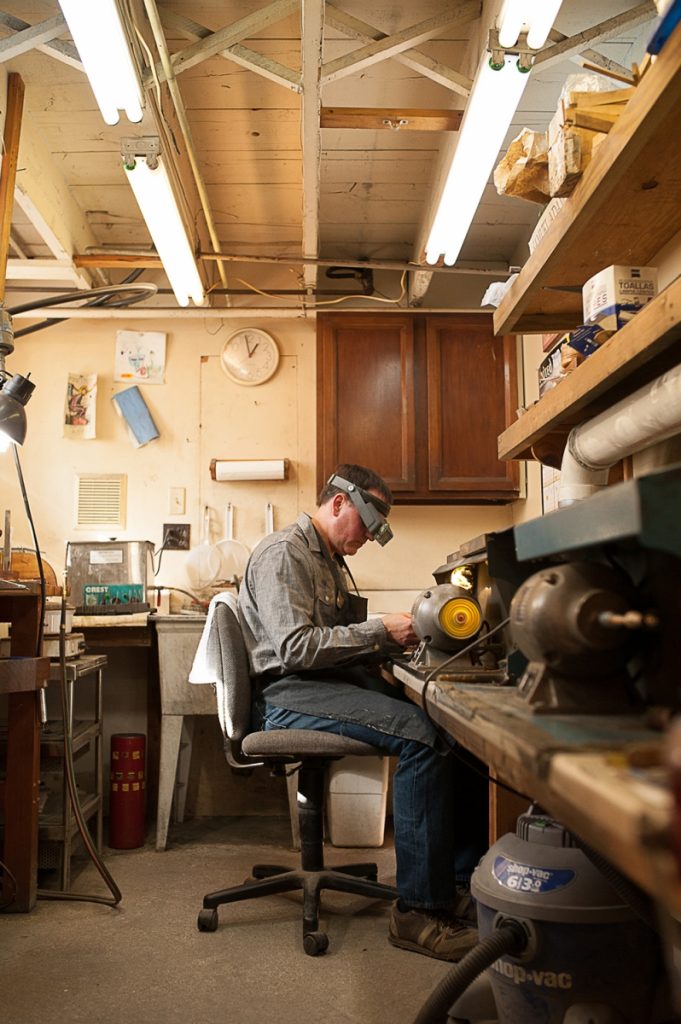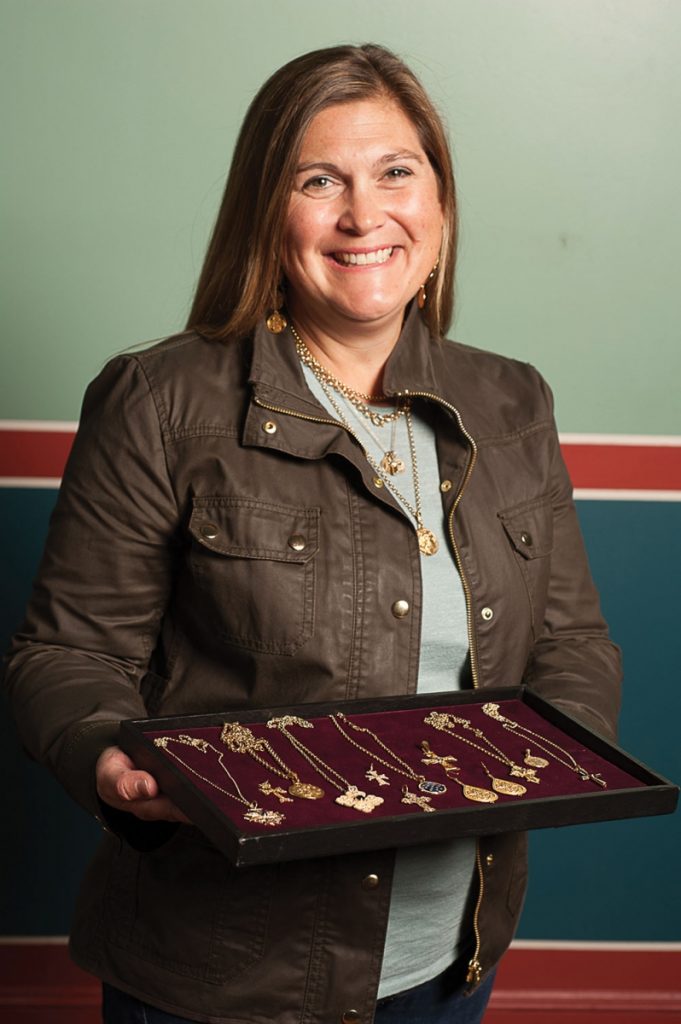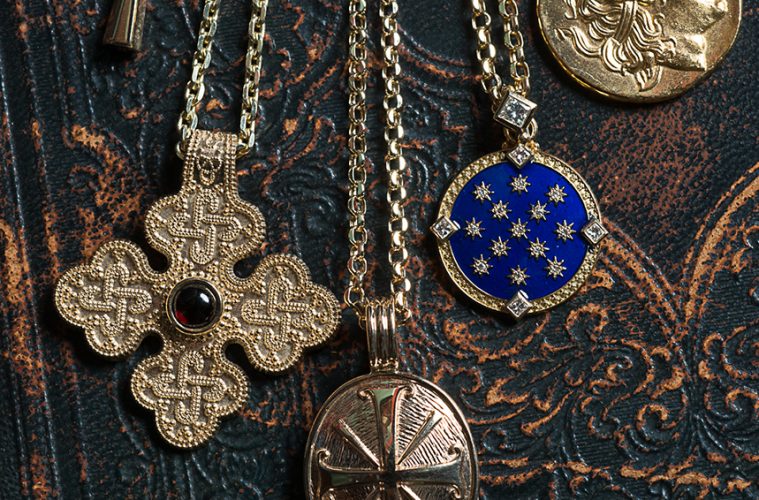Seraphima McLean holds up her latest creation, a pendant inspired by the Giotto-painted ceiling of the Scrovegni Chapel in Padua, Italy. A gold disc hanging from an 18-inch chain, its center has midnight blue enamel set with diamonds. Called the Celestial Fire Pendant, it is made in Ipswich.
The glittering piece of jewelry is both a departure for McLean’s company, Gallery Byzantium, and a continuation of a tradition begun by her father. And, she insists, the designs are not strictly hers, but are the result of collaboration between her and her husband, Brian, with input from her father.
“I studied art history and am constantly inspired to adapt elements of ancient art into new designs,” McLean says. “I come up with an idea, but then Brian draws the design on the computer. Before we go much further, we show it to my father to see what he thinks.”
Father Spyridon Schneider launched an unlikely business in 1987 when, as priest of Saint John the Russian Orthodox Church in Ipswich, he could not find crosses beautiful enough to commemorate important milestones in the Christian calendar.

“I traveled to the Middle East, Asia Minor, Istanbul, and Greece. To my great disappointment, I found nothing produced in the Byzantine manner,” he says.
“The ancient bazaars of Istanbul and the Golden Horn, continuously operating since the fourth century, were like shops in Times Square, packed with items from the commercial markets of the world, produced not to embody the ancient artistic traditions of indigenous peoples, but rather with an eye to satisfying the consumer instincts of Western Europeans and Americans. In fact, I discovered that the people who live in the shadow of the world’s most remarkable architectural and artistic wonders have lost the aesthetic traditions which produced them.”
Schneider made a series of crosses and medallions fashioned after Byzantine art works, as well as Easter egg pendants inspired by Faberge originals. He sold them via mail order for about six years, closing shop when the demands of his congregation and his family left him with no time for making gold and silver jewelry. But his daughter, Seraphima, passionate about art and about Byzantine art in particular, relaunched Gallery Byzantium in 2001.
Today she, her husband, and two employees do it all: design the jewelry, cast and finish it, and set it with precious and semiprecious gemstones. Brian photographs the finished pieces for catalogs produced twice a year, for the Easter and Christmas seasons.

“We do not have anything made in China or India; we feel very strongly about making everything here,” McLean says. “People sometimes tell us that we could save ever so much money by doing that, but we control everything, including the quality and the karats.
“The vast majority of our sales are still mostly crosses,” she explains. “With time, we expect to sell more earrings and other jewelry.”
The cross designs are encyclopedic: They include the lobed Saint Theodora, the Celtic Kilklispeen, the classic Sinai, the crystal cross, (a strikingly contemporary design that dates to the third century), an ornate Jerusalem cross, a simple Saint Sophia, a Greek key-like Saint Ninian, and a blocky Phos Zoe cross. The latter is engraved with the Greek letters phi, omega, and sigma, spelling phos; and zeta, omega, and Eta, which spell Zoe. (Phos is Greek for light and zoe is Greek for life.) There are a number of variations on the Saint Olga cross, whose three bars are dear to the Russian Orthodox faith. One of the newer designs, the Birka cross, reproduces a 9th-century grave find from near Stockholm, Sweden. Some crosses are set with rubies, garnets, sapphires, diamonds, or carnelians; all are available in sterling silver and 14-karat gold.
The newer, less liturgical pieces also draw on the opulent art of the Byzantine world. A pair of cufflinks depicts a bas-relief of the emperor Constantine, while disc-shaped earrings pay homage to a 7th-century Byzantine gold body chain. Peacocks, an ancient symbol of royalty, appear on earrings, as do the twin-headed eagles that became symbolic of Czarist Russia.
“The Byzantine empire was a time of faith and opulence, a high point of the arts,” McLean says. “It is a time period that needs to be honored and preserved. Making these pieces brings together my love of the arts and all things Byzantine, jewelry, and my faith.”
Recently she saw a breakthrough in her efforts to publicize Gallery Byzantium when America’s two biggest fashion magazines, Vogue and W, featured its designs.
“People are desperate for something that means something,” McLean says. “We are thinking of doing a line of Christmas tree ornaments. They will be fairly religious, with angels, stars, and the like.”
She also wants to launch a line of intaglio jewelry and, perhaps, opulent Byzantine-designed silk scarves with the heft and saturated colors of the famed Hermès silk twill scarves.
“My hope, in preserving ancient Byzantine treasures and heritage, is that they now become modern heirlooms for generations to come.”
Gallery Byzantium
16 Mt. Pleasant Ave. Ipswich
978-356-0259

